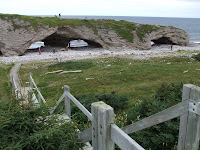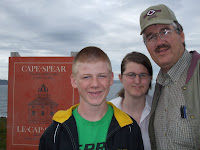
From Prince Edward Island we drove directly through Nova Scotia and Cape Breton Island to get to the Newfoundland ferry. The kids and I found the 6-hour crossing to be abit hard on the constitution, but Allan had fun acting like the drunken sailor, weaving from one side of the aisle to the other.

 We took a rest day in Corner Brook, and did a day-trip out along the Captain Cook Trail, that borders the Bay of Islands. Captain James Cook surveyed the area in 1767. The scenery was beautiful, with the many islands in the water.
We took a rest day in Corner Brook, and did a day-trip out along the Captain Cook Trail, that borders the Bay of Islands. Captain James Cook surveyed the area in 1767. The scenery was beautiful, with the many islands in the water.

 Next, we drove up the Viking Trail to the north, on the western side of the island. We drove through the UNESCO World Heritage Site of Gros Morne National Park, and after 4 or 5 more hours of driving, we found ourselves at the northern tip of Newfoundland. We stayed at Viking RV Park, which got us in the mood for another UNESCO World Heritage Site: L'Anse Aux Meadows. This is the where Norsemen established a settlement in North America around the year 1000 A.D. It was a fabulous site, and the National Park rangers were wonderful at giving us the background of the place: how it was discovered, details about the archaeological dig, and the items discovered that prooved that this was a genuine Norse site.
Next, we drove up the Viking Trail to the north, on the western side of the island. We drove through the UNESCO World Heritage Site of Gros Morne National Park, and after 4 or 5 more hours of driving, we found ourselves at the northern tip of Newfoundland. We stayed at Viking RV Park, which got us in the mood for another UNESCO World Heritage Site: L'Anse Aux Meadows. This is the where Norsemen established a settlement in North America around the year 1000 A.D. It was a fabulous site, and the National Park rangers were wonderful at giving us the background of the place: how it was discovered, details about the archaeological dig, and the items discovered that prooved that this was a genuine Norse site.Later we drove for a half hour to St. Anthony and sat on the cliff for an hour. We managed to see a far-off iceberg (although it was past their season), and a couple of whales swimming by, as well as a couple of pods of porpoises. A real thrill.
On our way back south down the peninsula, we stopped at a provincial park called the Arches. Here we saw how the ocean carved out holes in the rocks, and formed archways. The boys loved climbing all over the rocks.
 We returned to the main body of Newfoundland and took a few days to drive along the Trans Canada Highway to St. Johns (first exploring around Twillingate Peninsula). At St. Johns, the colorful houses are a site to see. We learned the history of Signal Hill, and its importance during the World Wars, and also as the point where Marconi received the first trans-Atlantic radio-wave transmissions in 1901.
We returned to the main body of Newfoundland and took a few days to drive along the Trans Canada Highway to St. Johns (first exploring around Twillingate Peninsula). At St. Johns, the colorful houses are a site to see. We learned the history of Signal Hill, and its importance during the World Wars, and also as the point where Marconi received the first trans-Atlantic radio-wave transmissions in 1901.No trip to St. Johns is complete without a stop at Cape Spear, the eastern-most point of land in the Western Hemisphere. We took the appropriate tourist photos, and also toured the historic lighthouse on the cape.


It was time to leave Newfoundland, so we drove across the island again, stopping at the Joey Smallwood view point at Gambo. (Joey Smallwood was the man who brought Newfoundland into Confederation in 1949.) The ferry-crossing back to Nova Scotia was much calmer, and I enjoyed standing at the bow and trying to catch photos of the many pods of porpoises that crossed our path. Alas, they were all too fast, but it was a fun way to end our trip to the wonderful province of Newfoundland. :)











No comments:
Post a Comment